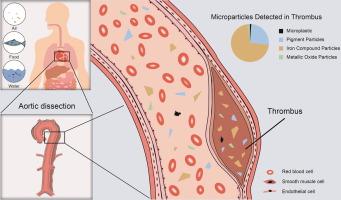Journal of Advanced Research ( IF 10.7 ) Pub Date : 2022-09-15 , DOI: 10.1016/j.jare.2022.09.004 Di Wu 1 , Yudong Feng 2 , Rui Wang 3 , Jin Jiang 1 , Quanquan Guan 1 , Xu Yang 1 , Hongcheng Wei 1 , Yankai Xia 1 , Yongming Luo 2

|
Introduction
Environmental microparticle is becoming a global pollutant and the entire population is increasingly exposed to the microparticles from artificial materials. The accumulation of microparticles including microplastics and its subsequent effects need to be investigated timely to keep sustainable development of human society.
Objectives
This study aimed to explore the accumulation of environmental particles in thrombus, the pathological structure in the blood circulation system.
Methods
Patients receiving cardiovascular surgical operations were screened and twenty-six thrombi were collected, digested and filtered. Non-soluble microparticles were enriched on the filter membrane and then were analyzed and identified with Raman Spectrometer. The associations of particle status (presence or absence) or particle number in the thrombus and clinical indicators were examined. One strict quality control-particle detection system was designed to eliminate environmental contaminations.
Results
Among twenty-six thrombi, sixteen contained eighty-seven identified particles ranging from 2.1 to 26.0 μm in size. The number of microparticles in each thrombus ranged from one to fifteen with the median reaching five. All the particles found in thrombi were irregularly block-shaped. Totally, twenty-one phthalocyanine particles, one Hostasol-Green particle, and one low-density polyethylene microplastic, which were from synthetic materials, were identified in thrombi. The rest microparticles included iron compounds and metallic oxides. After the adjustment for potential confounders, a significantly positive association between microparticle number and blood platelet levels was detected (P < 0.01).
Conclusion
This study provides the first photograph and Raman spectrum evidence of microparticles in thrombi. A large number of non-soluble particles including synthetic material microparticles could accumulate in arteries, suggesting that the risk of microparticle exposure was under-estimated and the re-evaluation of its health effects is urgently needed. There will be a series of reports on assessing the health effects of microparticle exposure in humans in the future and this research provided clues for the subsequent research.
中文翻译:

基于拉曼光谱证据在人体血栓中发现色素微粒和微塑料
介绍
环境微粒正在成为一种全球污染物,整个人口越来越多地接触人造材料产生的微粒。需要及时研究包括微塑料在内的微粒的积累及其后续影响,以保持人类社会的可持续发展。
目标
本研究旨在探讨环境颗粒物在血栓中的积累,以及血液循环系统中的病理结构。
方法
对接受心血管外科手术的患者进行筛查,收集、消化和过滤26个血栓。不溶性微粒富集在滤膜上,然后用拉曼光谱仪进行分析和鉴定。检查了血栓中颗粒状态(存在或不存在)或颗粒数量与临床指标的关联。设计了一套严格的质量控制——颗粒检测系统来消除环境污染。
结果
在 26 个血栓中,16 个血栓含有 87 个已识别的颗粒,尺寸范围为 2.1 至 26.0 μm。每个血栓中的微粒数量从1个到15个不等,中位数达到5个。血栓中发现的所有颗粒都是不规则的块状。血栓中总共鉴定出 21 个来自合成材料的酞菁颗粒、1 个 Hostasol-Green 颗粒和 1 个低密度聚乙烯微塑料。其余微粒包括铁化合物和金属氧化物。调整潜在混杂因素后,检测到微粒数量与血小板水平之间存在显着正相关(P < 0.01)。
结论
这项研究提供了血栓中微粒的第一张照片和拉曼光谱证据。包括合成材料微粒在内的大量不溶性颗粒可能在动脉中积聚,这表明微粒暴露的风险被低估,迫切需要重新评估其健康影响。未来将会出现一系列评估微粒暴露对人体健康影响的报告,这项研究为后续研究提供了线索。


























 京公网安备 11010802027423号
京公网安备 11010802027423号